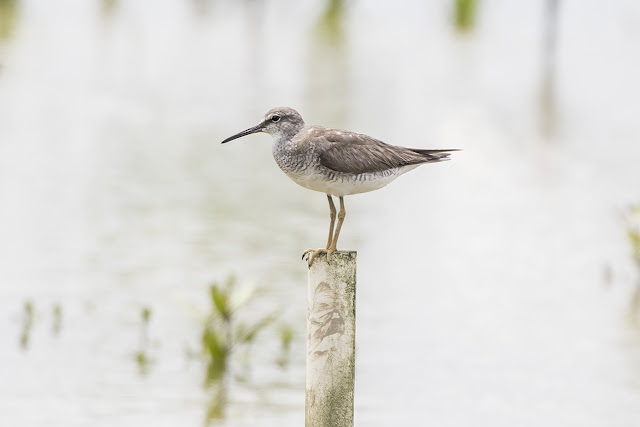If Narcissus Flycatcher represents one of the best of the migrating flycatchers in spring, Yellow-rumped Flycatcher surely is it's autumn counterpart. Due to the different migration route taken by these two similar species, we seldom see them together. Except for a few exceptional records, most records of Narcissus Flycatcher in Hong Kong are from spring, while most Hong Kong records of Yellow-rumped Flycatcher are from autumn. Therefore, Yellow-rumped is probably one of the most iconic autumn migrant we have in Hong Kong. A few of these had been spotted at Ho Man Tin of late, I decided to give them a try. I saw no less than two individuals there, one had a peculiar spike growing out of it's knee, although it did not seem to affect the bird's mobility. I've never really encountered any photogenic Yellow-rumped Flycatcher before, so I was happy that finally changed!
Yellow-rumped Flycathcer - the friendliest individual I've encountered so far
The other individual was a bit more shy and kept it's distance from me, but still gave fairly good views overall. Sexing juveniles can be slightly tricky, as they look very similar to adult females, although I suspect the first individual as a juvenile male due to it's slightly more contrasting wing-bars.
Yellow-rumped Flycatcher - 2nd individual at Ho Man Tin
Other than the Yellow-rumped Flycatchers, I saw very little else of particular interest at Ho Man Tin. Most birds are going through moult after a long breeding season, not looking their best, this scruffy looking Blue Whistling Thrush for example was missing most of it's tail feathers.
Blue Whistling Thrush - extremely scruffy
Tai Po Kau had not been particularly productive, with most highly sought after species well hidden. A few common species does provide some photo opportunity, including Velvet-fronted Nuthatch and Streak-breasted Scimitar Babbler.
Velvet-fronted Nuthatch
Streak-breasted Scimitar Babbler
One of my better encounter along the red walk was perhaps a few Great Barbet at close range, they were feeding in a fruiting tree along the trail, I flushed them at first, but with patience they cautiously returned. For this relatively common species, good views are surprisingly hard to come by, one individual perched in the open, showing off it's colourful plumage.
Great Barbet - a species I hear much more often than I see
Rhesus Macaques are often seen at Tai Po Kau, unlike those bold and mischievous macaques near Shing Mun, these were actually quite shy and did not like my presence, they will constantly scold at me until I leave their sight.
Rhesus Macaque
Wader numbers at Mai Po had picked up significantly, with a good range of species on display at Deep Bay, including Asian Dowitcher and Long-billed Dowitcher. I only had my 100-400mm lens with me and most birds were too far for any photos, many Grey-tailed Tattlers were amongst some of the closest waders to the bird hide. Juvenile Common Redshank is not something we often see outside of early autumn, at first glance they can look slightly similar to Greater Yellowlegs...
Grey-tailed Tattler
Common Redshank - juvenile
Other than birds, mudskippers can also be quite good fun to watch. The largest species at Mai Po being Boleophthalmus pectinirostris, also known as the Blue-spotted Mudskippers, they are probably the most entertaining of the three species, males engage in epic battles as they raise their sails and wrestle with each other to show their dominance. The much smaller Periophthalmus modestus are far less physical, males with raise their sails and jump into the air to attract mates. While the least common of the three species of Mudskippers found at Mai Po, the Periophthalmus magnuspinnatus can often be found sitting on trunks of mangroves during high tide.
Boleophthalmus pectinirostris
Periophthalmus modestus
Periophthalmus magnuspinnatus














No comments:
Post a Comment